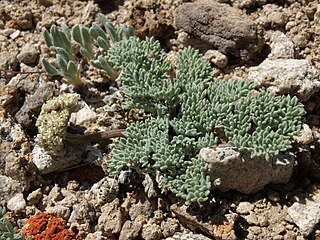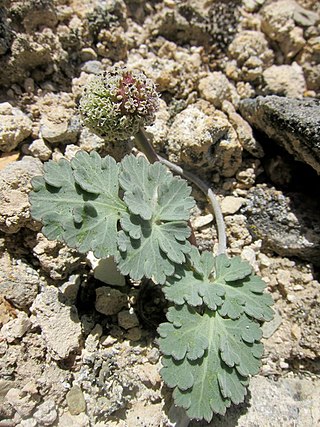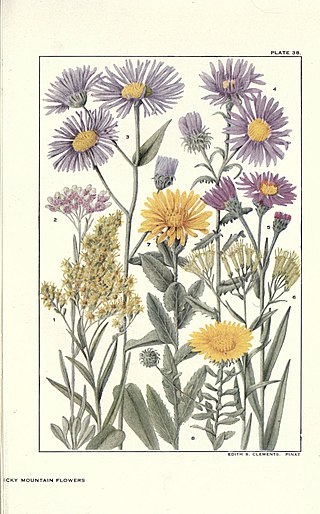Cymopterus multinervatus is a species of flowering plant in the carrot family known by the common name purplenerve springparsley. It is a perennial herb native to the southwestern United States, including the desert regions. It is stemless, producing leaves and inflorescence at ground level from a taproot. The leaves are erect on petioles of a few centimeters in length, with a fleshy blade dissected into waxy multilobed leaflets. The inflorescence arises on a stout purple or greenish peduncle up to about 14 centimeters tall. At the top is a rounded cluster of purple flowers sheathed in purple-veined bracts.

Cymopterus is a genus of perennial plants in the family Apiaceae native to western North America. They are commonly known as the springparsleys. They are mostly stemless, taprooted perennial herbs with leaves at ground level and flowering scapes bearing yellow, white, or purple flowers.
Cymopterus aboriginum is a species of flowering plant in the carrot family known by the common name Indian springparsley.

Cymopterus cinerarius is a species of flowering plant in the carrot family known by the common name gray springparsley. This small plant is native to the US states of California and Nevada, where it grows on the rocky talus of the Sierra Nevada. This plant has a short stem and lies against the ground or draped over rocky debris. Its distinctive leaves are only a few centimeters long and dissected into segments of a few millimeters in length. The gray-green segments are thick, pointed lobes with a bumpy textured surface and a waxy epidermal coating. From the center of this patch of leaflets sprouts an erect peduncle holding the flowers. The peduncle and the umbels of flowers are reddish-green or brown and the umbel has very large wrinkly bracts which are more visible than the actual white flower corolla.

Cymopterus gilmanii is a species of flowering plant in the carrot family known by the common name Gilman's springparsley.

Cymopterus globosus is a species of flowering plant in the carrot family known by the common name globe springparsley. This plant is native to the sandy flats extending between eastern California and Utah in the western United States. It is a low, stemless plant with leaves parallel to or lying flat on the ground. The green-gray parsley-shaped leaves are divided into several leaflets, which are further divided into neatly pointed segments. One or more tall purple or red-brown peduncles hold an inflorescence which is a spherical umbel densely packed with white or pinkish-purple flowers. They may be held in pairs atop the peduncle, and are often heavy enough to bend the peduncle to the ground.
Cymopterus ripleyi is a species of flowering plant in the carrot family known by the common name Ripley's springparsley, or Ripley's cymopterus. It is native to Nevada, Arizona and eastern California, where it grows in habitat with sandy soils, such as deserts. It is a stemless perennial herb, producing leaves and inflorescence from the taproot. The shiny, hairless leaves have small, rounded blades with approximately three leaflets each divided into lobes. The leaves are borne on petioles up to 10 centimeters long. The inflorescence is a spherical cluster of purplish or off-white flowers atop a long peduncle.

Schoenocrambe argillacea is a rare species of flowering plant in the mustard family known by the common names clay reed-mustard, Uinta Basin plainsmustard, and clay thelypody.

Phacelia submutica is a rare species of flowering plant in the borage family known by the common name De Beque phacelia. It is endemic to Colorado in the United States, where it is limited to the Piceance Basin in two counties. It is threatened by petroleum exploration. It was federally listed as a threatened species of the United States on July 27, 2011, a ruling which took effect on August 26, 2011.

Cymopterus beckii is a rare species of flowering plant in the carrot family known by the common names featherleaf springparsley, Beck springparsley, and pinnate springparsley. It is native to Utah and Arizona in the United States. There are disjunct occurrences at Capitol Reef National Park and in the Abajo Mountains of San Juan County, Utah. It has also been reported from Navajo County, Arizona.
Cymopterus goodrichii is a rare species of flowering plant in the carrot family known by the common name Toiyabe springparsley. It is endemic to Nevada in the United States, where it occurs in the Toiyabe and West Humboldt Ranges.
Thelesperma pubescens is a species of flowering plants in the aster family known by the common names hairy greenthread and Uinta greenthread. It is native to Wyoming and Utah in the United States. This species was first described in 1983.

The Albion Mountains are a mountain range in the U.S. states of Idaho (~99%) and Utah (~1%), spanning Cassia County, Idaho and barely reaching into Box Elder County, Utah. The highest point in the range is Cache Peak at 10,339 feet (3,151 m), and the range is a part of the Basin and Range Province. Most of the mountains are part of the Albion Division of the Minidoka Ranger District of Sawtooth National Forest.

Cymopterus davisii is a species of flowering plant in the carrot family known by the common name Davis's springparsley. This small, flat, taprooted perennial is endemic to Idaho in the United States, where it occurs in the Albion Mountains. The plant is found in the Albion Division of the Minidoka Ranger District of Sawtooth National Forest. It reaches approximately 7 in (18 cm) in height with a short stem that is sheathed by fibrous leaf bases. Numerous leaves form a whorl around yellow-flowered umbels.

Aquilegia laramiensis is a species of flowering plant in the buttercup family known by the common name Laramie columbine. It is endemic to Wyoming in the United States, where it is known only from the Laramie Mountains.

Draba globosa is a species of flowering plant in the family Brassicaceae known by the common names beavertip draba, round-fruited draba, and rockcress draba. It is native to the western United States, where it occurs in Idaho, Montana, Utah, Wyoming, and possibly Colorado.

Xanthisma coloradoense is a species of flowering plant in the family Asteraceae known by the common name Colorado tansyaster. It is native to Colorado and Wyoming in the United States.

Physaria parvula is a species of flowering plant in the family Brassicaceae known by the common name pygmy bladderpod. It is native to the Western United States, where it can be found in Colorado, Utah, and Wyoming.

Cymopterus glomeratus , now including Cymopterus acaulis, is a flowering plant. This plant is an aromatic plant of the family Apiaceae, a family of commonly known as the “celery, carrot, or parsley” family. The genus name comes from the Greek word, “Cyma” which means “wave” and “Pteron” which means “wing”, and combines to form the genus “Cymopterus”.

Dieteria bigelovii, or Bigelow's tansyaster, is a North American species of plants in the family Asteraceae. It is native to the southwestern United States.















